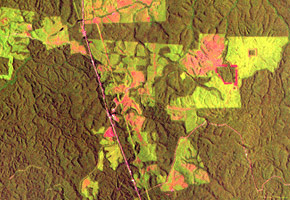

Nature highlights a project conceived by Thomas Lovejoy, a cooperative effort by Inpa and the Smithsonian to study the influence of deforestation on fauna and flora in the Amazon Forest
Nature highlights a project conceived by Thomas Lovejoy, a cooperative effort by Inpa and the Smithsonian to study the influence of deforestation on fauna and flora in the Amazon Forest.
Nature highlights a project conceived by Thomas Lovejoy, a cooperative effort by Inpa and the Smithsonian to study the influence of deforestation on fauna and flora in the Amazon Forest.

Nature highlights a project conceived by Thomas Lovejoy, a cooperative effort by Inpa and the Smithsonian to study the influence of deforestation on fauna and flora in the Amazon Forest
By Frances Jones
Agência FAPESP – A scientific project begun 35 years ago in the heart of the Amazon Forest is bearing fruit around the globe. A million-dollar experiment developed by an international team on the island of Borneo in Asia is the most recent study to replicate and expand upon the Dynamic Biological Project on Forest Fragments (PDBFF), the result of cooperation between the National Institute of Amazon Research (Inpa) and the Smithsonian Institution.
The history of the experiment in the Amazon, conceived by U.S. ecologist Thomas Lovejoy, and the subsequent projects are detailed by Jeff Tollefson in a four-page report in the April 18 edition of Nature magazine.
“It is in fact a wonderful overview of the forest fragments work, and the many benefits, for example training graduate students, and inspiring other research projects on fragmentation,” commented Lovejoy in an interview with Agência FAPESP.
A professor at George Mason University, Lovejoy received the Blue Planet Prize, considered the Nobel Prize for the Environment, in 2012. He was responsible for introducing the term “biological diversity” to the scientific community.
According to Inpa, the PDBFF, which is still ongoing, has a dual mission: to determine the ecological consequences of the deforestation and fragmentation of forests for fauna and flora in the Amazon, and to use information generated from different sectors of society to encourage the conservation and rational use of forest resources.
The Nature report details how Lovejoy conducted the experiment in an area of approximately 1,000 square kilometers to the north of Manaus with the collaboration of cattle ranchers in the region. Within this perimeter, he and his team, a group of Brazilian researchers, delimited 11 sections of 1, 10 and 100 hectares of the forest. The WWF also participated in the study, which today receives resources from the National Science Foundation in the United States.
After analysis of the fauna and flora in the demarcated locations, chainsaws and fire were used in selected areas. Everything that was outside the demarcated zones of forest was destroyed, but everything within the areas remained intact. Within this framework, the scientists could study the short- and long-term consequences of forest isolation for animals and plants.
“The effects have spread like a câncer deep into the uncut área. Large trees have perished. The spider monkeys have moved out, as have the army-ant colonies, and many of the birds that depend on them,” the article reads.
“By documenting pervasive changes in the forest fragments, Lovejoy and his co-workers provided the first hard data that conservationists needed to promote the preservation of extensive areas of intact forest,” the report continues. In the 1970s, the ecologists debated whether it would better to protect large continuous areas or hotspots of lower biodiversity.
In 1996, the researcher Bill Laurance, then a scientist at the Smithsonian, was invited by Lovejoy to work with the data produced by the experiment. In the following year, Laurance and his team reported a loss of 36% of the biomass in the first 100 meters of intact forest fragments over an isolation period of 17 years. The calculations suggest that the loss of biomass surrounding the limits of the forest due to fragmentation could produce up to 150 million tons of carbon emissions annually.
The experience, according to the magazine, indicated a possible solution: the creation of wildlife corridors using secondary forests, grown in the regions in which pastures were abandoned, to allow circulation of animals.
The studies have never been interrupted and currently continue. How many species in the islands of intact forest are doomed to extinction? Have the rapid variations in insect populations and other animals prompted long-term changes in the dispersal of seeds and in the diversity of fauna? What role will global warming play? These are some of the questions that, according to the report, remain unanswered.
The text of the Nature article can be read at: www.nature.com/news/forest-ecology-splinters-of-the-amazon-1.12816
Republish
The Agency FAPESP licenses news via Creative Commons (CC-BY-NC-ND) so that they can be republished free of charge and in a simple way by other digital or printed vehicles. Agência FAPESP must be credited as the source of the content being republished and the name of the reporter (if any) must be attributed. Using the HMTL button below allows compliance with these rules, detailed in Digital Republishing Policy FAPESP.





